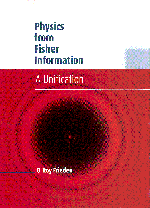Book contents
- Frontmatter
- Contents
- 0 Introduction
- 1 What is Fisher information?
- 2 Fisher information in a vector world
- 3 Extreme physical information
- 4 Derivation of relativistic quantum mechanics
- 5 Classical electrodynamics
- 6 The Einstein field equation of general relativity
- 7 Classical statistical physics
- 8 Power spectral 1/f noise
- 9 Physical constants and the 1/x probability law
- 10 Constrained-likelihood quantum measurement theory
- 11 Research topics
- 12 Summing up
- Appendix A Solutions common to entropy and Fisher I-extremization
- Appendix B Cramer–Rao inequalities for vector data
- Appendix C Cramer–Rao inequality for an imaginary parameter
- Appendix D Simplified derivation of the Schroedinger wave equation
- Appendix E Factorization of the Klein–Gordon information
- Appendix F Evaluation of certain integrals
- Appendix G Schroedinger wave equation as a non-relativistic limit
- Appendix H Non-uniqueness of potential A for finite boundaries
- References
- Index
6 - The Einstein field equation of general relativity
Published online by Cambridge University Press: 30 January 2010
- Frontmatter
- Contents
- 0 Introduction
- 1 What is Fisher information?
- 2 Fisher information in a vector world
- 3 Extreme physical information
- 4 Derivation of relativistic quantum mechanics
- 5 Classical electrodynamics
- 6 The Einstein field equation of general relativity
- 7 Classical statistical physics
- 8 Power spectral 1/f noise
- 9 Physical constants and the 1/x probability law
- 10 Constrained-likelihood quantum measurement theory
- 11 Research topics
- 12 Summing up
- Appendix A Solutions common to entropy and Fisher I-extremization
- Appendix B Cramer–Rao inequalities for vector data
- Appendix C Cramer–Rao inequality for an imaginary parameter
- Appendix D Simplified derivation of the Schroedinger wave equation
- Appendix E Factorization of the Klein–Gordon information
- Appendix F Evaluation of certain integrals
- Appendix G Schroedinger wave equation as a non-relativistic limit
- Appendix H Non-uniqueness of potential A for finite boundaries
- References
- Index
Summary
Motivation
As is well-known, gravitational effects are caused by a local distortion of space and time. The Einstein field equation relates this distortion to the local density of momentum and energy. This phenomenon seems, outwardly, quite different from the electromagnetic one just covered. However, luckily, this is not the case. As viewed by EPI they are very nearly the same.
This chapter on gravity is placed right after the one on electromagnetic theory because the two phenomena derive by practically identical steps. Each mathematical operation of the EPI derivation of the electromagnetic wave equation has a 1:1 counterpart in derivation of the weak-field Einstein field equation. For clarity, we will point out the correspondences as they occur. The main mathematical difference is one of dimensionality: quantities in the electromagnetic derivation are vectors, i.e., singly subscripted, whereas corresponding quantities in the gravitational derivation are doubly subscripted tensors. This does not amount to much added difficulty, however.
A further similarity between the two problems is in the simplicity of the final step: in Chap. 5 this was to show that Maxwell's equations follow from the wave equation. Likewise, here, we will proceed from the weak-field approximation to the general-field result. In fact, the argumentation in this final step is even simpler here than it was in getting Maxwell's equations.
Gravitational theory uses tensor quantities and manipulations. We introduce these in the section to follow, restricting attention to those that are necessary to the EPI derivation that follows. A fuller education in tensor algebra may be found, e.g., in Misner et al. (1973) or Landau and Lifshitz (1951).
- Type
- Chapter
- Information
- Physics from Fisher InformationA Unification, pp. 161 - 178Publisher: Cambridge University PressPrint publication year: 1998



